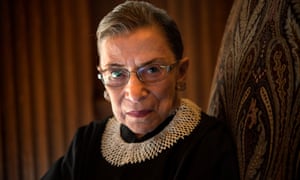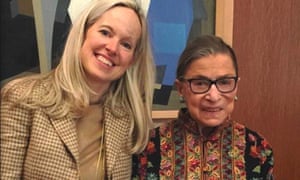Extract from The Guardian

The revered US supreme court justice’s former clerk recalls a friend who cared passionately about the dignity and rights of all
by Lisa Beattie Frelinghuysen
Before she became the Notorious RBG, Justice Ginsburg was my hero. I had worked at the American Civil Liberties Union and knew of her advocacy establishing gender equality in the law. I was beyond excited years later to interview for a judicial clerkship with her, and yet the interview began in the most awkward way. She appeared at the door of her Watergate apartment, elegant and soft spoken. I noticed my writing samples in her left hand, a bright red circle around a few words on the first page. My heart sank. Did I actually send an article with an error?! She noted that I omitted a “per curium” parenthetical following a case name. I smiled at her precision – she was of course correct – and explained that I was writing for a lay audience, omitting the Latin to keep their attention. She gave me a kind pass. We proceeded to have a rich discussion about gender equality and reproductive justice. I was thrilled when she then offered me the clerkship.
That year, October term 1995, a big women’s rights case came before the supreme court: United States v Virginia, challenging the male-only admission policy at Virginia Military Institute (VMI). The experience of researching, drafting, and polishing the landmark opinion brought us close together. She cared a great deal about this case. Drawing on case law she helped establish as a women’s rights litigator, this was her first gender equality opinion as a supreme court justice. She was persuasive here too: a large majority of the justices joined her opinion, in which she noted that VMI had continued to exclude women, when our constitutional understanding of who was included in “We the People” had expanded.
Her good friend, Justice Scalia, dissented, and despite their close friendship, he took the opportunity to level a few swings at the majority. Justice Ginsburg diffused the heat with her usual understated wit: “the dissent sees fire where there is no flame”, and teased Scalia for years about being the lone dissenter.
The justice and I returned 20 years later to visit Virginia Military Institute. I remember sitting in the back of her car, with opera music blaring, driving up to the famous barracks. The women cadets, in their tidy and fitted uniforms, were thriving, eager to solve world problems. They thanked the justice for opening the doors that allowed them to pursue their dreams, and we enjoyed a chuckle about the school’s struggle about what to do with the cadets’ hair: requiring shaved heads, then braids, and then neat buns at the base of their hats.
People joked that she wasn’t much of a chit-chatter, but we talked about a wide range of topics – literature, opera, politics, travel, and family – she just brought more depth to the discussion. We stayed in close touch after my clerkship, visiting with each other in Washington DC and New York City. She was always so warm with my four children, welcoming them with hugs, sharing new books, answering their questions, showing them her collection of jabots or judicial collars, each with a story.
My all-time favourite dinner with her happened on the night of Trump’s inauguration. I was bringing my family to DC for the Women’s March the following day, and I invited Justice Ginsburg and Gloria Steinem to have dinner with us. Here were the two remarkable 80-year-old matriarchs of the women’s rights movement who had worked in very different ways – Gloria Steinem, writing provocative pieces and marching in protest, and Justice Ginsburg, quietly fighting for equal rights through the judiciary – but they admired each other and recognised the importance of the other’s work in their shared goals.
At dinner, my daughter asked the justice if she had ever marched. She thought for a moment and said: “I did carry the baton in my high school band.” Protesting in the streets was not her gig; she preferred persuading judges in quiet courtrooms.
In recent years, Justice Ginsburg became a sort of pop-culture icon. A Tumblr blog calling her the Notorious RBG (referencing a rap star, the Notorious BIG) emerged. The court had shifted to the right, and she developed a compelling dissenting voice. She called out the majority’s opinions, in a language that inspired the general public. And the 2018 RBG documentary contributed to the public’s understanding of her commitment and impact. She became an 85-year-old superhero, with that closet of jabots in lieu of capes. I think people felt that she was watching out for them, on the high bench, including and protecting them.
She was not one to toot her own horn. When the directors of the documentary asked her for permission, she originally declined to participate: “wait until I step off the bench,” she said. I flew to DC to encourage her to reconsider, thinking we were all in need of a hero’s story, and eventually she relented. We had not seen the completed film when we flew to Sundance for the premiere. At the end of the screening, there was a Q&A with the directors, and the first question from the audience was: “Has Justice Ginsburg seen the film and what did she think of it?” One of the directors said: “Actually, the justice is in the audience, and we are as curious as you.” Everyone waited with bated breath. The justice said: “I had very high expectations for this film … and it has exceeded all my expectations.” The directors let out a great sigh of reliefand invited the justice to join the Q&A. No surprise, every question that followed was for her.

Petite and elegant, she was a warrior. She never stopped fighting for equality and justice and, personally, she battled four-plus rounds of cancer, never missing a day on the bench. Over the last few years, she fought hard to stay healthy, working out, accepting additional rounds of chemo. Her beloved family took turns staying with her during the pandemic, and her chambers staff brought home her judicial work.
I last saw her in March of 2020 at her chambers, right before returning to shelter at home. Of coures, I stood 10 feet away while we talked. In her advanced age, her head was often angled downward, and I was having trouble hearing her, so I knelt down on the floor. It was not lost on me that I was kneeling before the justice. She was fighting another round of cancer then but was determined to keep up with work. Toward the end of my visit, she lay down on her couch to rest. This was a first, and a sudden reminder that she was mortal.
At her memorial service, as an honorary pallbearer, I escorted her casket up through the sea of 120 law clerks to her family. On the night after the service, I stood vigil by her casket, on the top of the supreme court steps under the portico, full of gratitude for her tireless commitment to equality. I watched a multitude of people – all races, genders, religions – file across the bottom of the steps to pay respects. One woman stopped and held up a sign: “Thank you for protecting my rights.” Justice Ginsburg cared passionately about all individuals, their rights and their dignity. She was a superhero of we the people.
No comments:
Post a Comment